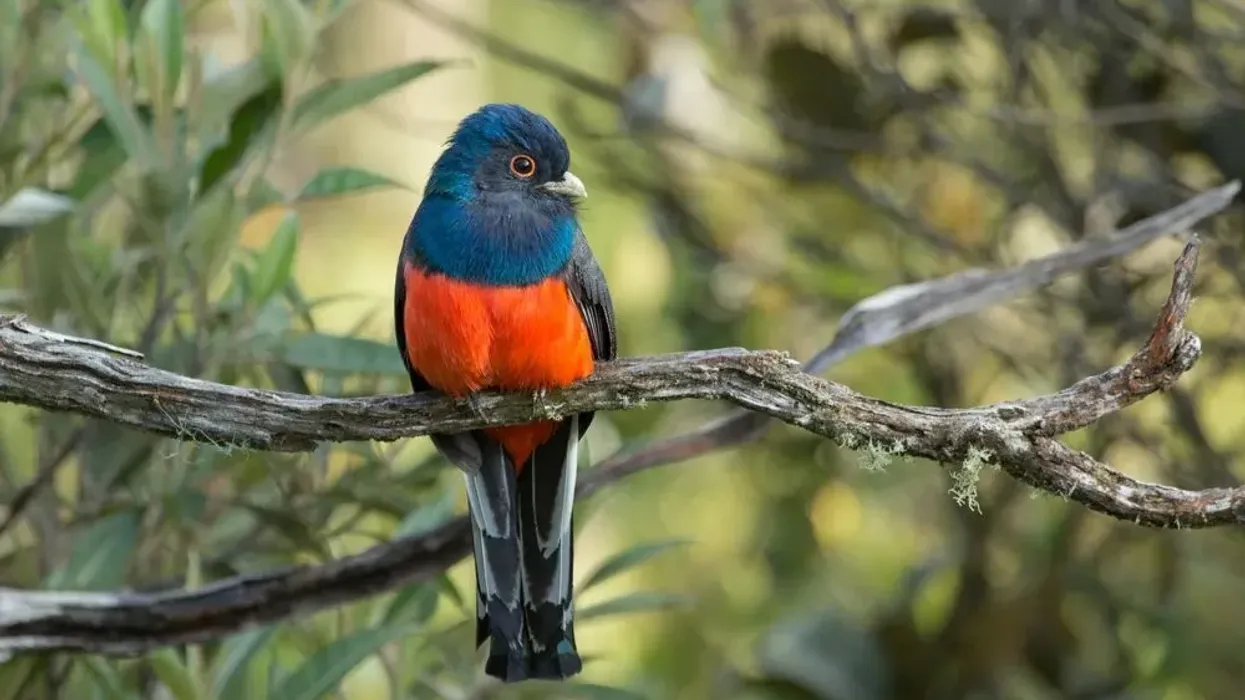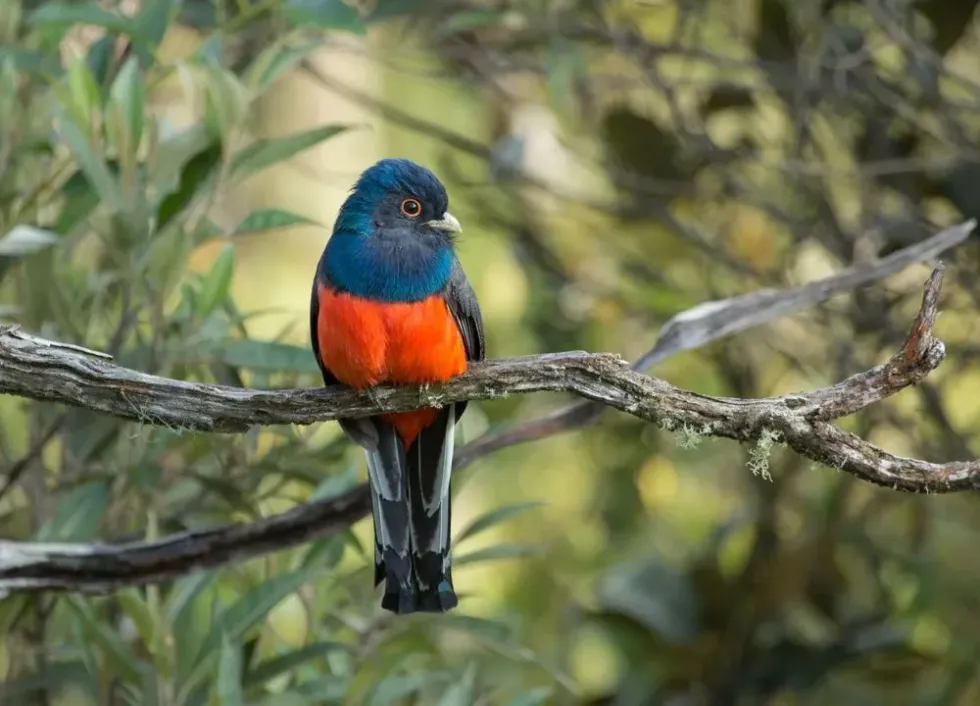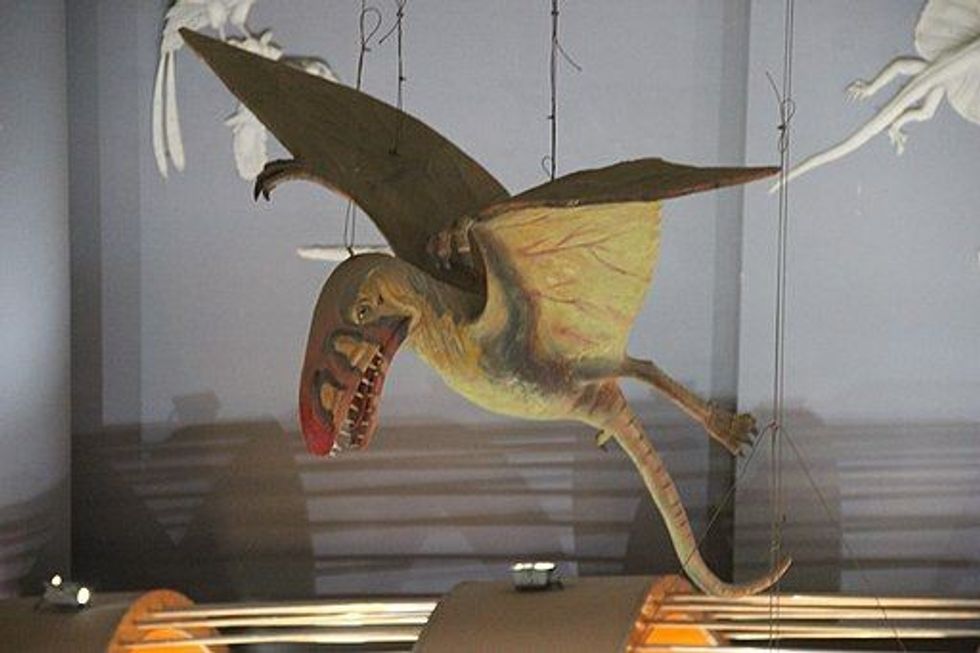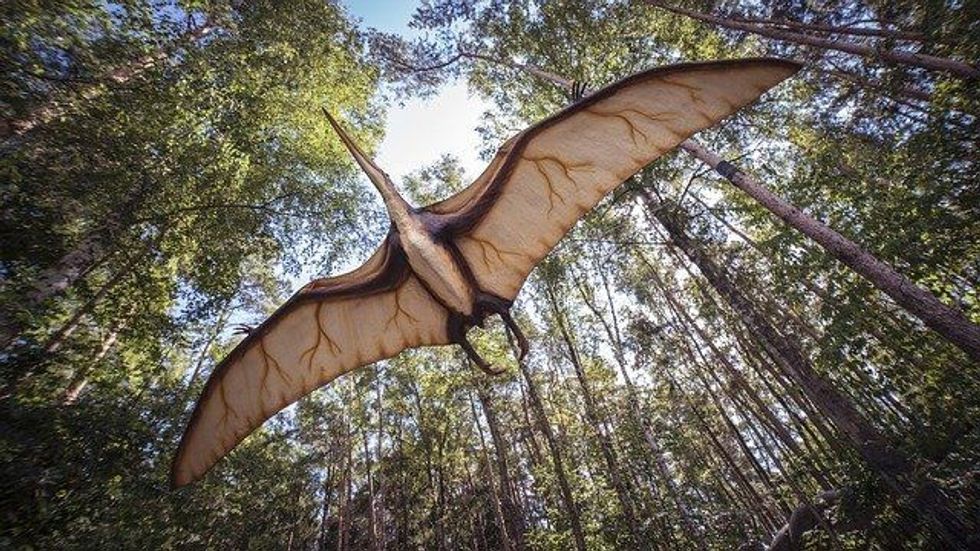The Surucua trogon (Trogon surrucura) is a bird species of the order Trogoniformes, family Trogonidae. The body color range of this species is orange, turquoise blue, black, turquoise green, and gray.
There are two subspecies, the northern (Trogon) aurantius that has an orange-yellow belly, and nominate birds that have a red belly. Sometimes, the northern auranticus species considered the full species can also be called the Brazilian trogon (Trogon aurantius). Mathurin Jacques Brisson, a French zoologist, introduced the Trogon genus in 1760.
This taxonomy is a derivation of an ancient Greek term, which translates to 'gnawing' and 'fruit-eating'. There are 20 described species in this genus.
The species of this genus mainly occupy woodlands and forests. The female birds are very difficult to spot on a field. The family Trogonidae has seven genera consisting of 46 species.
Quetzals and trogons are considered to be one of the most beautiful bird species. Trogons are usually not a migratory species, but some birds can move around their local habitat regions.
If you like reading this article about the Surucua trogon, learn more facts about the Ani bird and ovenbird on Kidadl.
Surucua Trogon Interesting Facts
What type of animal is a Surucua trogon?
The Surucua trogon (Trogon surrucura, Vieillot 1817) is a trogon bird of the order Trogoniformes, family Trogonidae, and phylum Chordata. An adult trogon bird can easily catch insects mid-air, flying, or plucking them out of tree branches.
This trogon species is called Trogon surucua in France and Trogón surucuá in Spain. This species is an arboreal and solitary trogon, feeding early in the morning and late afternoon. They use a 'still-perching' for predatory and anti-predatory reasons.
Like owls, the Surucua trogon can turn its head 180 degrees. The male trogon becomes territorial in the breeding season and around food resources. There are two subspecies, one with the red belly is referred to as the southern Surucua trogon (Trogón surucuá). A bird with a orange-yellow belly is referred to as the northern Surucua trogon (Trogon aurantius).
What class of animal does a Surucua trogon belong to?
The Surucua trogon (Trogon surrucura, Vieillot 1817) of the order Trogoniformes, family Trogonidae belongs to the class of Aves of animals.
How many Surucua trogons are there in the world?
The population distribution of this Surucua trogon (Trogon surrucura, Vieillot 1817) bird in the world has not yet been evaluated, according to BirdLife International. Also, BirdLife International describes both the northern (Trogon aurantius) and the southern trogon (Trogón surucuá) subspecies as common birds of the world.
Where does a Surucua trogon live?
The geographic distribution of an adult Surucua trogon (Trogon surrucura, vieillot 1817) extends to eastern Paraguay, south-eastern Brazil, Uruguay, and north-eastern Argentina. The subspecies, Trogon surrucura surrucura is found in the east to south-east Brazil, east Paraguay, north-east Argentina, and towards the south in Uruguay. The geographic location of the subspecies Trogon surrucura aurantius is in south-eastern Brazil.
The related species, the blue-crowned trogon (Trogon curucui), occupies a geographic range in Ecuador, Brazil, Paraguay, Peru, Bolivia, Argentina, and Colombia. Also, the geographic range of the green-backed trogon (Trogon viridis) is across South America including Trinidad, the Guiana Shield, the Amazon, and the Atlantic forest in eastern Brazil.
What is a Surucua trogon's habitat?
The Surucua trogon range of habitat consists of mainly tropical and subtropical forest regions. This adult bird is found in primary forest, tall secondary forests, semi-deciduous woodland, and humid forest. Most trogon bird species are sedentary, but some Surucua trogon birds migrate to the north from south regions in the austral winter.
Who do Surucua trogons live with?
The adult Surucua trogon (Trogon surrucura) is a solitary bird. This trogon bird only comes together with other birds in the breeding season.
How long does a Surucua trogon live?
The adult Trogon surrucura (Trogon surucua) and the subspecies (aurantius) in the world live for around seven years.
How do they reproduce?
The breeding season of Trogon surrucura (Trogon surucua,vieillot 1817) occurs anytime between September and December. The nest of a Surucua trogon (Trogon surucua) is built in holes or cavities of trees, termite mounds, a thick tree-fern trunk, or sometimes in a tree termitarium. The adult male is territorial and also defends food sources.
The adult male tends to chase away other nest predators directly flying towards them with calls. The Surucua trogon female lays two to four white eggs.
Surucua trogon eggs are incubated for 17-19 days by both adult males and females. Also, males and females feed insects to the young ones. After hatching, the juveniles fledge after 20 days.
What is their conservation status?
The conservation status of the Surucua trogon (Trogon surrucura) is evaluated by Birdlife International as Least Concern as they are common birds of the world. However, Birdlife International specifies that the population distribution in the world is susceptible to habitat fragmentation and destruction.
Surucua Trogon Fun Facts
What do Surucua trogons look like?
The Trogón surucuá (Surucua trogon) of the family Trogonidae and genus Trogon has a compact body with a short neck. The Surucua trogon birds has short legs, making it difficult to walk.
Also, this Surucua trogon bird cannot turn around on a branch without the use of wings. The wings are strong but short.
The most unique feature of this trogon bird is the zygodactylous feet that have their toes in pairs, allowing them to grip the perching branch firmly. The adult male of the nominate Surucua trogon has royal blue breast, neck, and crown that becomes turquoise blue as it extends to their nape.
This male Surucua trogon bird has a black throat, cheek, and fore-crown.
The upper parts have a coppery-green color that turns turquoise green on their tails. The belly on a male Surucua trogon's underparts is pink-red with gray flanks.
The Trogon surucua has white under tails with black bars. The bills are green-gray and eyes are dark brown with orange eyering.
The dull gray female Surucua trogon has white bars on its upper wing. The female bird has black upper tail feathers.
A female lack eyerings but has white spots behind the eyes. The adult female is similar to an immature female and immature male Trogon surrucura that have black tips on the under tails. Trogon surrucura aurantius birds have a yellow eyering and orange-yellow belly and the female shows a white mid-belly.
These latter species sometimes are considered separate birds, named the Brazilian trogon, and the name orange-bellied trogon has also been suggested. The male Trogon curucui (blue-crowned trogon) has colorful red, green, black, white, and blue colors that the females lack. The green-backed trogon (Trogon viridis) also show various colors like green, blue, orange, red, and white.

How cute are they?
The Trogón surucuá (Surucua trogon) is considered to be beautiful rather than cute.
How do they communicate?
The Surucua trogon (Trogon surrucura) communicates through body language, songs or calls, and visuals
How big is a Surucua trogon?
The Surucua trogon (Trogon surrucura) is 10.2 in (26 cm) in length. The colorful quetzals of the same family as these species are almost three times the length of the Surucua trogon.
How fast can a Surucua trogon fly?
The flight speed of Surucua trogon (Trogon surrucura) of the family Trogonidae is not known.
How much does a Surucua trogon weigh?
The Surucua trogon (Trogon surrucura) weighs 0.16 lb (73 g).
What are the male and female names of the species?
There is no specific name given to Trogon surrucura (Surucua Trogon) male and female birds of the world.
What would you call a baby Surucua trogon?
There is no specific name given to a Surucua trogon baby.
What do they eat?
This species of the trogon genus are omnivores. They feed on insects and fruit. Some insects they feed on are grasshoppers, moths, termites, ants, spiders, caterpillars, and cicadas.
Are they dangerous?
No, this colorful trogon bird species is not dangerous to human beings.
Would they make a good pet?
No, this wild species would make great pets. They thrive in tropical and subtropical forest regions in the world.
Did you know...
All the other trogon birds of the world mostly occupy tropical and subtropical geographic habitats.
The Trogon curucui or blue-crowned trogon prefers heavily degraded former forests and moist lowland forests and is found in Paraguay.
The Trogon viridis or green-backed trogonm also called the Amazonian white-tailed trogon, grows up to 11-12 in (28-30 cm) in length.
How many species of trogons are there?
There are 20 species within the Trogon genus and the family Trogonidae has 46 species in the world.
Some of these birds of the world are the lattice-tailed trogon (Trogon clathratus) in Panama and Costa Rica, the Ecuadorian trogon (Trogon mesurus) in western Ecuador and northwestern Peru, the black-tailed trogon (Trogon melanurus) in north-western South America and next to Panama, and the citrioline trogon (Trogon citreolu) found in western Mexico.
What does Surucua trogon mean?
The term 'trogon' means 'to nibble' as these birds nibble or gnaw holes in trees for their nest. The term 'surucua' is a Spanish word that translates 'to surface'. The literal meaning of Surucua is 'surface nibbles'.
Here at Kidadl, we have carefully created lots of interesting family-friendly animal facts for everyone to discover! For more relatable content, check out these Louisiana waterthrush facts and giant cowbird facts for kids.
You can even occupy yourself at home by coloring in one of our free printable bird coloring pages.








